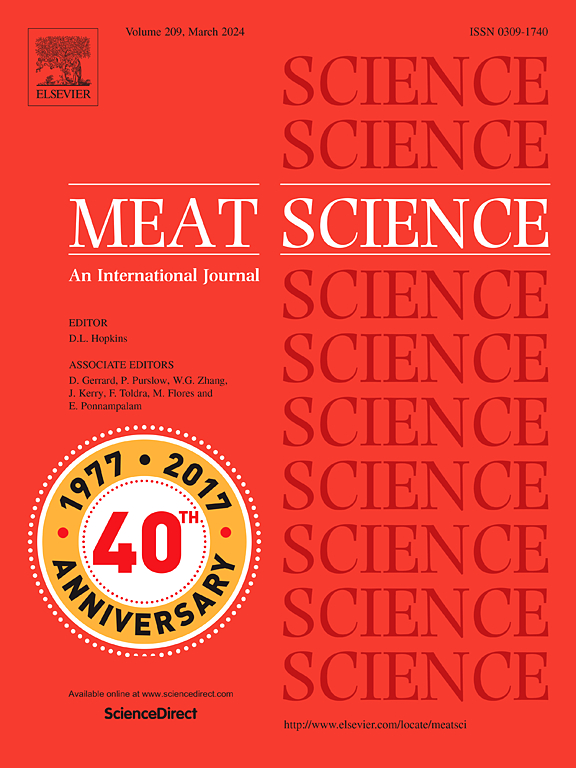本地猪的品种和加工方法如何影响消费者对干腌火腿的偏好
IF 6.1
1区 农林科学
Q1 Agricultural and Biological Sciences
引用次数: 0
摘要
使用当地品种Krškopolje猪生产两种干腌火腿,修剪/形状为“Kraški pršut”(KK)或“Istrski pršut”(IK)。消费者(n = 118)被招募来评估火腿在盲,预期和知情的测试。总体喜欢度以5分李克特量表评定,而感官知觉在盲测和预期测试中采用check - all - thatapply方法进行评估。在盲测、预期测试和知情测试中,KK获得的喜欢分数高于IK。具体而言,对于KK,喜欢程度在知情测试中最高,在盲测试中最低,在预期测试中居中,表明当地品种的信息对消费者的感知有积极影响。相比之下,IK在盲测和知情测试中都显示出相似的喜欢分数,而预期的喜欢分数明显更高,这表明期望和实际经验之间存在不匹配。Check-All-That-Apply结果与对应分析显示,消费者根据感官描述符对IK和KK火腿进行了区分。此外,分析强调了预期和感知感官描述符之间的差异。本文章由计算机程序翻译,如有差异,请以英文原文为准。
How local pig breed and processing methods affect consumer preferences for dry-cured ham
Two dry-cured hams were produced using a local breed Krškopolje pig, trimmed/shaped either as ‘Kraški pršut’ (K![]() K) or ‘Istrski pršut’ (I
K) or ‘Istrski pršut’ (I![]() K). Consumers (n = 118) were recruited to evaluate the hams in blind, expected, and informed tests. Overall liking was rated on a 5-point Likert scale, while sensory perceptions were assessed with Check-All-That-Apply method in blind and expected tests. In blind, expected, and informed test, K
K). Consumers (n = 118) were recruited to evaluate the hams in blind, expected, and informed tests. Overall liking was rated on a 5-point Likert scale, while sensory perceptions were assessed with Check-All-That-Apply method in blind and expected tests. In blind, expected, and informed test, K![]() K received higher liking scores than I
K received higher liking scores than I![]() K. Specifically, for K
K. Specifically, for K![]() K, liking was the highest in informed, the lowest in the blind, and intermediate in the expected test, suggesting that information about local breed positively influenced consumer perception. In contrast, I
K, liking was the highest in informed, the lowest in the blind, and intermediate in the expected test, suggesting that information about local breed positively influenced consumer perception. In contrast, I![]() K showed similar liking scores in both, blind and informed tests, while the expected liking was notably higher, indicating a mismatch between expectations and actual experience. Check-All-That-Apply results, analyzed with correspondence analysis, showed that I
K showed similar liking scores in both, blind and informed tests, while the expected liking was notably higher, indicating a mismatch between expectations and actual experience. Check-All-That-Apply results, analyzed with correspondence analysis, showed that I![]() K and K
K and K![]() K hams were differentiated by consumers based on sensory descriptors. Furthermore, the analysis highlighted differences between expected and perceived sensory descriptors.
K hams were differentiated by consumers based on sensory descriptors. Furthermore, the analysis highlighted differences between expected and perceived sensory descriptors.
求助全文
通过发布文献求助,成功后即可免费获取论文全文。
去求助
来源期刊

Meat Science
工程技术-食品科技
CiteScore
12.60
自引率
9.90%
发文量
282
审稿时长
60 days
期刊介绍:
The aim of Meat Science is to serve as a suitable platform for the dissemination of interdisciplinary and international knowledge on all factors influencing the properties of meat. While the journal primarily focuses on the flesh of mammals, contributions related to poultry will be considered if they enhance the overall understanding of the relationship between muscle nature and meat quality post mortem. Additionally, papers on large birds (e.g., emus, ostriches) as well as wild-captured mammals and crocodiles will be welcomed.
 求助内容:
求助内容: 应助结果提醒方式:
应助结果提醒方式:


